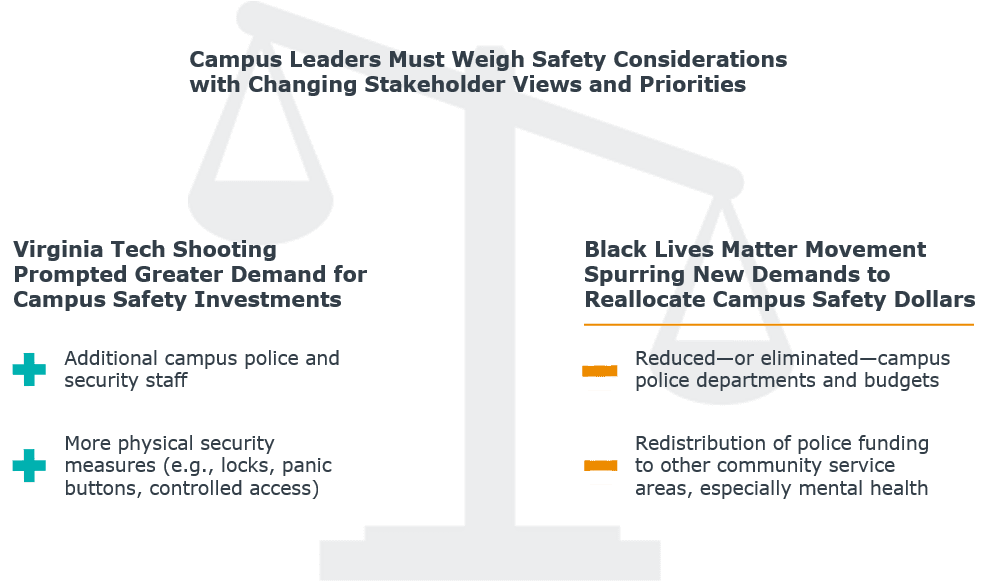How to Take a More Holistic Campus Safety Approach
Brooke Thayer, Senior Director, Research Development
In 1894, Yale University set a precedent by establishing the first college police department. Since then, campus unrest, federal compliance requirements, and active shooter threats have prompted many other institutions to follow suit. Today, more than two-thirds of campuses with over 2,500 students employ sworn police officers who have full arrest powers within their jurisdiction and are often armed.
But recent instances of police brutality and racial injustice have prompted concerns about the role of police on college campuses. Following the tragic murders of George Floyd and Breonna Taylor earlier this year, many campus stakeholders called for their institutions to defund, disarm, or disband their campus police forces. This has put new pressures on campus leaders to weigh safety obligations and risks with community concerns and priorities. Two examples of this difficult balancing act are shown in the graphic below.

To navigate these pressures, some campus leaders are reframing the campus safety conversation around community experiences and needs—rather than specific demands or reforms—and embracing a more holistic and stakeholder-centric approach.
A new campus safety model
Historically, most institutions’ safety models were police-centric. Cabinet members delegated most safety responsibilities to campus police, including tasks like wellness checks and crowd control. In this model, police leaders focused primarily on student safety programming and ensuring physical security through building infrastructure and campus patrols.
But given the growing complexity of campus safety needs and constantly changing stakeholder priorities, some institutions are pioneering a more holistic approach. They’re shifting to a new model where leaders and campus units share safety responsibilities, incorporate the needs of all constituents (e.g., faculty, staff), and embrace a multi-dimensional view of safety (e.g., emotional, psychological).
In turn, these campus leaders are repositioning safety as an institution-wide priority, unifying stakeholders around a common goal, and spurring more creative and productive safety discussions. More information on both models and the benefits of this new approach is included below.
Transitioning to a more holistic campus safety model
Historic model: Police-centric
-
Assign all campus safety responsibilities to campus police (e.g., wellness checks, crime prevention, crowd control)
-
Focus on student safety services (e.g., residence hall programming, alcohol and drug education)
-
New model: Stakeholder-centric
Benefits of the new model
- Repositions safety as campus-wide priority, rather than the sole responsibility of campus police
- Shifts focus toward the shared goal of creating a safe campus for all community members
- Encourages more creative and inclusive discussions about campus safety needs and experiences
3 imperatives for campus leaders
EAB has identified three imperatives, listed below, for campus leaders looking to implement a more holistic safety approach. While decision-making authority differs across institutions, leaders from Finance and Administration, Student Affairs, and Campus Safety must partner to achieve these imperatives and ensure the safety of their entire campus community.
- Develop a shared vision for campus safety
- Align structures and staffing with strategy
- Modernize safety policies and procedures
Begin rethinking your campus safety approach by watching the webinar: Responding to New Pressures on Campus Safety and Police, where we walk through these three imperatives and provide examples of how institutions are approaching implementation on their campuses. Leaders can use this information to evaluate and improve upon their current campus safety model.
This resource requires EAB partnership access to view.
Access the research report
Learn how you can get access to this resource as well as hands-on support from our experts through Strategic Advisory Services.
Learn More